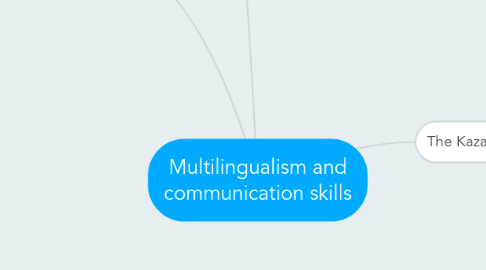
1. The international research
1.1. Lang communication practices (strategies) in intern multil environments
1.1.1. Translanguaging
1.1.1.1. Sı´lvia Melo-Pfeifer.Intercomprehension between Romance Languages and the role of English: a study of multilingual chat rooms
1.1.1.2. Margot van Mulken & Berna Hendriks. Your language or mine? or English as a lingua franca? Comparing effectiveness in English as a lingua franca and L1–L2 interactions: implications for corporate language policies
1.1.1.3. Chuchu & Noorashid. Language choice and co-construction of solidarity within interethnic communication in Kiudang/Mungkom
1.1.1.4. Jo Angouri and Marlene Miglbauer ‘And then we summarise in English for the others’: The lived experience of the multilingual workplace
1.1.1.5. Christoph A. Hafner, David C.S. Li, and Lindsay Miller. Language Choice Among Peers in Project-Based Learning: A Hong Kong Case Study of English Language Learners’ Plurilingual Practices in Out-of-Class Computer-Mediated Communication
1.1.1.6. Melinda Martin-Beltrán. “What Do You Want to Say?” How Adolescents Use Translanguaging to Expand Learning Opportunities
1.1.1.7. Jo Angouri. The multilingual reality of the multinational workplace: language policy and language use
1.1.1.8. Mingyue Gu. From opposition to transcendence: the language practices and ideologies of students in a multilingual university
1.1.1.9. Mariana Bono , Sílvia Melo-Pfeifer. Language negotiation in multilingual learning environments
1.1.2. Code-switching
1.1.2.1. Jo Angouri and Marlene Miglbauer ‘And then we summarise in English for the others’: The lived experience of the multilingual workplace
1.1.2.2. Code-switching in higher education in a multilingual environment: a Lebanese exploratory study Rima N. Bahousa∗ , Mona Baroud Nabhania and Nahla Nola Bacha
1.1.3. Receptive multilingualism
1.1.3.1. Hanna-Ilona Härmävaara. Facilitating mutual understanding in everyday interaction between Finns and Estonians
1.1.3.2. Kurt Braunmu¨ ller. Communication based on receptive multilingualism: advantages and disadvantages
1.1.4. Code-mixing
1.1.5. Definitions of lang strategies
1.1.5.1. Magdalena Malechová. MULTILINGUALISM AS A SOCIOLINGUISTIC CONTACT PHENOMENON WITH REGARD TO CURRENT FORMS OF MULTILINGUAL COMMUNICATION CODE-SWITCHING AS ONE OF THE CONTEMPORARY COMMUNICATION TRENDS
1.2. Multil communic and English
1.2.1. Sı´lvia Melo-Pfeifer.Intercomprehension between Romance Languages and the role of English: a study of multilingual chat rooms
1.2.2. Margot van Mulken & Berna Hendriks. Your language or mine? or English as a lingua franca? Comparing effectiveness in English as a lingua franca and L1–L2 interactions: implications for corporate language policies
1.2.3. Jo Angouri and Marlene Miglbauer ‘And then we summarise in English for the others’: The lived experience of the multilingual workplace
1.2.4. Christoph A. Hafner, David C.S. Li, and Lindsay Miller. Language Choice Among Peers in Project-Based Learning: A Hong Kong Case Study of English Language Learners’ Plurilingual Practices in Out-of-Class Computer-Mediated Communication
1.2.5. Cornelia Hülmbauer, Heike Böhringer, Barbara Seidlhofer. Introducing English as a lingua franca (ELF): Precursor and partner in intercultural communication
1.2.6. Jo Angouri. The multilingual reality of the multinational workplace: language policy and language use
1.3. Multil and social cohesion
1.3.1. Susan Coetzee-Van Rooy. Multilingualism and social cohesion: insights from South African students
1.3.2. Chuchu & Noorashid. Language choice and co-construction of solidarity within interethnic communication in Kiudang/Mungkom
1.3.3. English and social cohesion
1.3.3.1. Christoph A. Hafner, David C.S. Li, and Lindsay Miller. Language Choice Among Peers in Project-Based Learning: A Hong Kong Case Study of English Language Learners’ Plurilingual Practices in Out-of-Class Computer-Mediated Communication
1.3.4. Social cohesion. definition
1.3.4.1. Gal Ariely. Does Diversity Erode Social Cohesion? Conceptual and Methodological Issues
1.3.5. Ranu Basu. Multiculturalism Through Multilingualism in Schools: Emerging Places of “Integration” in Toronto
2. Terms
2.1. Multilingualism
2.1.1. Defining Multilingualism Jasone Cenoz
3. The Kazakhstani research
3.1. Multilingualism and multilingual education
3.1.1. AIGERIM SEITZHANOVA , ROMAN PLOKHIKH , RUSLAN BAIBURIEV , ANTONINA TSAREGORODTSEVA. ENGLISH AS THE MEDIUM OF INSTRUCTION: MODERN TENDENCY OF EDUCATION IN KAZAKHSTAN
3.1.2. Zhanar G. Shaikhyzada , Olga A. Andreyeva. Implementation of Multicultural and Multilingual Educational Model in the Republic of Kazakhstan
3.1.3. Shara Mazhitaeva , Gulnara Smagulova , Bahytgul Tuleuova. Multilingual Education as One of Priority Directions of Educational System Development in the Republic of Kazakhstan
3.1.4. Bibigul Yergaliyevna Yeskeldiyeva & Saule Zhaksylykbaevna Tazhibayeva. Multilingualism in Modern Kazakhstan New Challenges
3.1.5. Damira Jantassova. The Solution of Teaching English as A Foreign Language Integrating with Kazakh and Russian Languages to Students of Kazakhstan Technical Universities
3.1.6. Lyaila Turumbetova. Changes in the system of higher professional education in multiethnic Kazakhstan due to globalization
3.1.7. Alishariyeva Akbota. Bilingualism Among Young People In Kazakhstan
3.1.8. Sholpan Zharkynbekova, Aliya Aimoldina, Damira Akynova, Aliya Abaidilda, Zhanna Kuzar. The Role of Multilingual Education in the Process of Kazakhstani Identity Formation
3.1.9. Davronzhon GAIPOV, Yusuf YAYLACI, Kurtay ÇI Selim GUVERCIN. Formation of Multilingual Educational System in Kazakhstan Kazakh-Turkish High Schools
3.2. Social cohesion and interethnic relations
3.2.1. Askar Jumageldinov. CULTURAL IDENTIFICATION AND INTERETHNIC RELATIONS IN KAZAKHSTAN
3.3. Foreign students in KZ
3.3.1. Nurmambek Ramashov , Gulden N. Ramashova. Stages of International Cooperation Development in the Sphere of Foreign Students’ Education in Higher Educational Institutions of Kazakhstan
